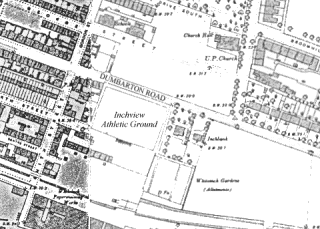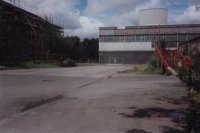Inchview

The Scottish FA Annual for season 1885-86 detailed the new ground: “Grounds, private, Inchview, Whiteinch. Cars pass ground every ten minutes. Dressing room on grounds.” By the start of season 1886-87 the club had set a table and seats erected inside the ropes for reporters. This example was followed a few months later by Queen’s Park and Renton.
Inchview saw a record crowd drawn to a Scottish Cup tie with Rangers in September 1887, when 8,000 watched Thistle beat their old rivals 2-1. There was veiled criticism of the pitch, though, “…the surface at Inchview disadvantages to away team…” The pitch was again criticised after the next Scottish Cup tie, against Queen’s Park, when the ground was described as “a very uncomfortable place to watch football in the wet”.
The club improved the club house during the break before season 1888-89 began, although the Scottish Umpire were not impressed, and opined that they should knock it down and start again.
Thistle were leasing Inchview on a short-term basis, and the committee were reluctant to spend money on the ground. However, over the summer of 1891 they finally sanctioned some improvements to the clubhouse and ground which they hoped would be appreciated by players and supporters.
The changes presumably were acceptable – at least no grumbles were made public – and in 1893 Inchview became a Scottish League ground as Thistle joined the inaugural Second Division season. The 13-1 victory over Glasgow Thistle in March 1894 was the highest recorded in a Scottish League fixture at that time, and was Thistle’s highest ever score for many years. However, the committee made some long-term ambitions clear when they announced that they were searching for a new ground after nine years – a ground that would be owned solely by the club, rather than being leased, with the attendant uncertainties leasing brought.
Although there was no immediate result to the ground search, it was a couple of years before problems with the ground were raised again. The pitch was re-aligned during the summer of 1896 and after just two months the players had taken a dislike to playing at home, much preferring to play away. The location and accommodation available was also being questioned. There were several vantage points around the ground that allowed non-payers a view of the game, while the lack of a stand was also commented upon. The committee’s response was that the “ground committee” had been meeting with local businesses, trying to raise funds for the move away from Whiteinch.
The meetings were successful, and just two months later, in November 1896, the “ground committee”, headed by Mr. R.W.Mitchell, announced the conclusion of negotiations for a new ground – Meadowside. On a field closer to Partick than Inchview, adjacent to the Meadowside Ferry, it was ambitiously planned to build a ground to house upwards of 20,000, with a grandstand and pavilion.
There was delight from Partick Thistle players, supporters and committee alike, and all looked forward to their new home. However, there was still time to create some excitement at old Inchview. Rangers visited in the Scottish Cup – a crowd of 6,000 turned up at Inchview for the game, many more watching from outside vantage points, while others still didn’t turn up over fears of overcrowding. A room in a house overlooking the field was requisitioned by the club for use as a pressroom. The game was lost 2-4.
Things were going well in the league. What better way to celebrate the new ground than playing top-class football in it. Thistle were second in the Second Division when the ground move was announced, but overtook Leith Athletic to win the division, and eventually to clinch promotion to the First Division.
Fittingly the last game at Inchview saw the return of some former players who had graced the Whiteinch pitch – John Proudfoot, John Wilkie and John Campbell brought their new Blackburn Rovers teammates to Glasgow for an exhibition game. Thistle won this last game at Inchview 4-3.
Now a new era of top football and a new ground waited for Thistle – at Meadowside.
 The location of the ground is beside the present north entrance to the Clyde Tunnel. The building which houses the Tunnel entrance, and a housing estate, have been built on the site of the ground. Prior to new roads and the tunnel buildings being built, Dumbarton Road would have continued from Balshagray to Whiteinch under the current Clydeside Expressway. The ground was situated at the junction of Balshagray Avenue and Dumbarton Road. Ironically, a goal has been painted on the wall of the Tunnel building.
The location of the ground is beside the present north entrance to the Clyde Tunnel. The building which houses the Tunnel entrance, and a housing estate, have been built on the site of the ground. Prior to new roads and the tunnel buildings being built, Dumbarton Road would have continued from Balshagray to Whiteinch under the current Clydeside Expressway. The ground was situated at the junction of Balshagray Avenue and Dumbarton Road. Ironically, a goal has been painted on the wall of the Tunnel building.
Categories
- Miscellaneous (16)
- Other clubs (15)
- Players (26)
- Thistle – early years (48)
- Thistle – general (5)
Football history links
- Ayr United archive
- Bill Shankly
- Falkirk Historian
- Gallant Pioneers – Early history of Rangers
- Glasgow Herald archive at Google
- Hibernian
- Hibernian Historical Trust
- London Hearts
- Partick Thistle history archive by StuTheJag
- Rangers History
- Scottish Football Historical Archive
- Scottish Football Museum
- Scottish Sports History
- ScottishLeague.net and forum
